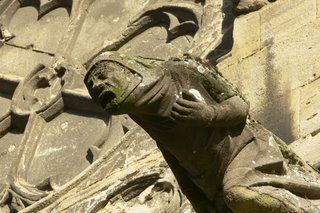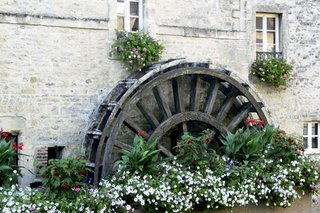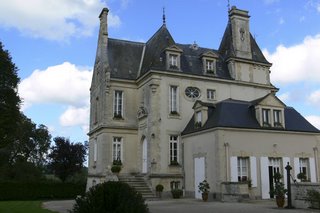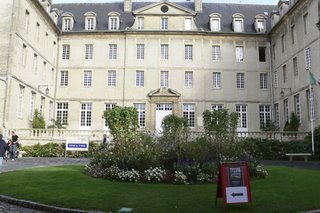
Ever since Susan and I first went to Gettysburg Battlefield in Pennsylvania we have wanted to visit the Normandy Beaches. We felt that such a visit to Omaha and Utah and Juno and Gold and Sword would be a perfect complement to the poignancy one finds in even the most casual stroll around the Peach Orchard or the Wheatfield or Devil’s Den. We also wanted to pay our respects to those men whose young lives ended here on French soil, just as we said hello (and goodbye) to those other young men whose lives ended on a handful of Pennsylvania farms in July of 1863. And to be given the opportunity to visit such a place at last is truly a gift. As an avid student of history over the years I have read a great deal about the Second World War and of course the prominent role D-Day played in that conflict. The stories that always affected me the most were the ones that brought you down to ground level. Stephen Ambrose got it absolutely right: the story of D-Day is the story of the men who fought there. And the closest you could get to that story here in France was strewn about the countryside in the cemeteries, large and small which remain little bits of Canada, The United States, Great Britain. (photo: detail from the cathedral in Bayeux.)
And so at last we went to Normandy, to see the Beaches. And afterward we wondered why we waited so long to go in the first place.
General impressions.
The drive to Normandy from Paris is through a countryside that reminded us both of western Massachusetts and upstate New York – in fact as we drove through the Seine valley we thought it looked quite like the Mohawk valley in New York. Once in Normandy and near the coast, however, parts of it reminded me of central Illinois, the flatness of the land and the number of large farms in particular. This was particularly true from the Canadian cemetery near Bency-sur-Mer; the headstones all face south (away from the direction of Juno beach) overlooking land that brings to mind the farms of western Ontario. Coincidence? Maybe.

After arriving in Bayeux we were struck by how peaceful the place is. Of course many of the tourists are gone now but still there were many of us cruising this corner of the world looking for something to inspire us, to remind us of what makes our species great and terrible at the same time. I sometimes wonder if today we often find it hard to find such inspiration, which maybe explains why we are so nostalgic about the men who came here and the things they did here. Maybe that’s what brings so many of us here again and again to find a sense of renewal. I don’t know. (photo: peaceful is the operative word here.)
Unlike Caen, a large unattractive city about 20 kms to the east, Bayeux makes for a perfect place to explore Normandy, to find whatever it is you came here looking for and take a bit of it home with you. The town is small, quaint and with a relatively low cost of living even for tourists. Bayeux was largely spared the destruction visited on nearly every other major city and town in this area during the war and today the town derives much of its livelihood off of tourists coming to see the tapestry and the beaches. Moreover the town sits just about square in the middle between the Commonwealth and US beachheads. Day trips up the Cotentin peninsula or to Mont Saint Michel are easy as well.
We found our bed and breakfast the Chateau d'Argouges about 10 kms west Bayeaux and we couldn'thave chosen a more perfect location, with splendid views of the Norman countryside right from our windows. The roads throughout this part of France are excellent and the signage is both frequent and easy to use. A good map and/or road atlas is pretty much a necessity though. If you know where you’re going they’ll get you there.
Details.
There are several ways to see the Beaches: you can do a multi-day tour by bus, you can take the train to Bayeux and then do mini excursions by local tour companies (or rent bikes) or you can do what we did and rent a car and do the whole thing yourself. Whatever makes you feel comfortable. The important thing is to go.
We rented a car, a Renault Clio through Thrifty – we used them frequently in Italy and always found their prices to be the lowest. We soon discovered that at Orly airport – which is south of Paris – Thrifty outsources to a company called ADA, which was not located at either terminal (like the other car rental agencies) and we had to take a shuttle bus to the nearby Holiday Inn where we picked up our car. Although there was no record of a reservation for me we got a car nevertheless and were soon on our way out of Paris, or rather the “Isle de France” and heading west to Normandy.
The drive took us less than three hours with a short stop along the way for gas (or rather diesel) and a bite of lunch. The weather was pretty lousy with rain off and on for most of the drive.

The rain stopped by the time we reached Bayeux although it remained overcast for the remainder of the day and evening. Anyway, we found our way to the bed and breakfast, the Chateau d’Argouges, arriving between 2 and 3 in the afternoon. Located about 10 kms west of Bayeux the chateau is located in an almost picture postcard pastoral setting, truly quite stunning and the view from our room was spectacular. It was also very quiet; I mean very quiet – and deathly quiet at night. And dark. We hadn’t seen that much black at night since we lived up on the mountain in Chittenden! We have certainly become acclimatized to the noise and light pollution of Paris. (Route de Russy, 14400 Mosles; tel: 02 31 92 52 90.)
Note ther is also a Hotel D'Argouges located right inside Bayeux and as far as I know there is no connection between the two places. The Rough Guide to France recommended the hotel in town and actually when I googled "Argouges" I got the Chateau and, well one thing led to another ans thinking I had the hotel I booked the chateau. Anyway it worked out fine. I'd be curious to know what the hotel is like though.
Our hosts were pleasant but spoke virtually no English – which was curious since nearly all the guests staying there were either American or English as it turned out. We settled into the room, Susan unpacked and I stood around looking goofy. That lasted for about 20 minutes and then we headed off to Bayeux and the tapestry.

Soon after arriving in the historic city center we parked the car, and walked several blocks to the tourist information office. (You can check them out online as well.) After picking up some literature and buying a good map of the Beaches we strolled over to see the world-famous Bayeux Tapestry. Truly an amazing work of art and of course an amazing story as well – this 70-meter long tapestry, hand-woven by English monks, tells the story of how William, Duke of Normandy came to invade England in 1066, and in one swift stroke change the course of European history forever. (photo: building which houses the Tapestry. Pretty exciting huh?)
This exhibition is probably one of the best-arranged interpretative presentations I have ever seen in any museum anywhere.
After you pay your money you enter an enormous room where you will find an exact copy of the tapestry but with the story outlined in great deal along with explanatory notes to help you fully understand the impact of both the thing itself and the tale it is weaving for you. Reading the entire tapestry would probably take about a half a day but we spent quite a bit of our time here nonetheless. After the copy there is a small but very well done series of dioramas detailing much of the peripheral elements of the period of history discussed in the tapestry’s story.
From there you go into a theater and get a 14-minute presentation on the story again and then when you actually get to the room that holds the fabric itself. Oh and opt for the audio guide – it’s free and will help explain (again) the 58 or so elements of the story for you as you wend your way along the tapestry. Plan to spend a little time here. You’ll need it. But we thought it worth every minute. Oh and it’s pretty cold in the room so be prepared.
After we left the tapestry building we strolled around the town, stopping at a small café for an aperitif. We eventually and found our way to dinner at a restaurant on the Rue des Cuisiniers (street of the kitchens), which, and this should come as no surprise, is where most of the restaurants are located. We can certainly recommend our dining choice for the evening: Le Pommier. The service was friendly, helpful and willing to struggle along with us in our French – a very nice touch. The food was quite good and quite reasonably priced: less than €50 for the two of us without wine. The “menus” (fixed price menus) were very reasonable at €21 and €28, definitely a good deal (we both opted for the €21). Located at 38-40 rue des Cuisiniers; teL; 02 31 21 52 10.)
After dinner we strolled back to the car and left for the dark, quiet French countryside -- and a big day tomorrow.
Wish you were here,
Steve
No comments:
Post a Comment